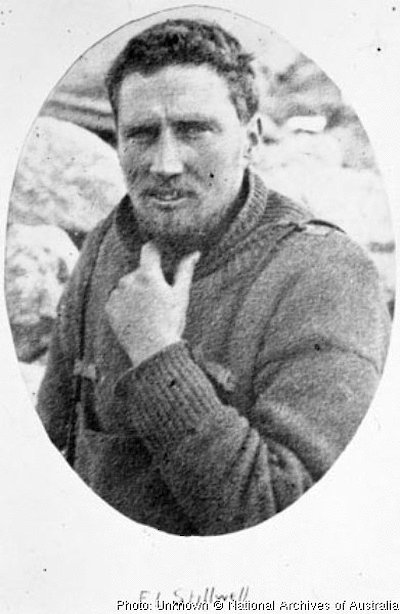Frank Leslie Stillwell
AAE position: Geologist
In their own words
Breaking camp, we set out on a northerly course for the coast down gently falling snowfields. Gradually there opened up a beautiful vista of sea, dotted with floes and rocky islets (many of which were ice-capped) … Every accessible rock was covered with rookeries of Adélie penguins; the first chicks were just hatched.
— From Stillwell’s report in Home of the Blizzard
Born in Melbourne in 1888, Frank Stillwell was an outstanding geology student at the University of Melbourne, graduating with first-class honours. Mawson had little difficulty in determining his suitability to join what was planned to be the pre-eminent Antarctic scientific expedition of its time.
Stillwell worked as a geologist with the AAE, leading two sledging parties which did topographic and geological exploration for about 100 km along the coast to the east of Cape Denison. He was fortunate to survive one of these journeys, when carbon monoxide fumes in an unventilated snow cave caused him and both his companions to lose consciousness.
Stillwell’s study, The metamorphic rocks of Adélie Land, published in the AAE Reports, earned him a University of Melbourne DSc in 1916. His maps, along with Hodgeman’s, graced the pages of Mawson’s Home of the Blizzard.
Stillwell became an acting lecturer in mineralogy at the University of Adelaide in 1914. He enlisted with the Australian army in 1916, but was withdrawn by the Commonwealth government to help establish the ‘Commonwealth Advisory Council of Science and Industry’ — an organisation which was later to become CSIRO.
Through most of the 1920s Stillwell worked at mines at Broken Hill, Bendigo and Kalgoorlie (the latter with a university research grant), and visited mines in Europe, South Africa and North America.
From 1929 until his retirement in 1953 Stillwell was a research scientist in petrology and mineralogy at the new Commonwealth science agency. Stillwell became an Australian and world authority in the field of ore mineralogy. His section investigated nearly every major ore deposit in Australia as well as mill products from mines everywhere in the country, and did much to improve mine production efficiency by tracing the causes of losses in recovery of metals from ores.
Stillwell remained essentially a scientist. He was never an empire-builder — his first assistant was not appointed until 1935 and he worked for nearly 20 years in a cramped laboratory in the University of Melbourne’s geology department.
He retired from the CSIRO in 1953. He received many honours around his retirement, including the publication of the Stillwell Anniversary Volume of the Australasian Institute of Mining and Metallurgy in 1958. Among other honours were Mawson’s naming of Stillwell Island in Antarctica after him, and a new mineral named Stillwellite. His most treasured membership was of the Royal Society of Victoria, to which he made a large bequest.
Stillwell, who remained a bachelor throughout his life, died in Melbourne in 1963.

